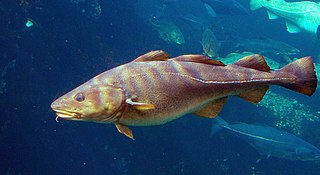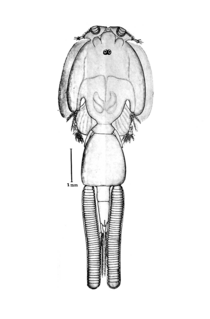
Cod is the common name for the demersal fish genus Gadus, belonging to the family Gadidae. Cod is also used as part of the common name for a number of other fish species, and one species that belongs to genus Gadus is commonly not called cod.

The Atlantic cod is a benthopelagic fish of the family Gadidae, widely consumed by humans. It is also commercially known as cod or codling. Dry cod may be prepared as unsalted stockfish, and as cured salt cod or clipfish.

The haddock is a saltwater ray-finned fish from the family Gadidae, the true cods. It is the only species in the monotypic genus Melanogrammus. It is found in the North Atlantic Ocean and associated seas where it is an important species for fisheries, especially in northern Europe where it is marketed fresh, frozen and smoked; smoked varieties include the Finnan haddie and the Arbroath smokie.

Anisakis is a genus of parasitic nematodes that have life cycles involving fish and marine mammals. They are infective to humans and cause anisakiasis. People who produce immunoglobulin E in response to this parasite may subsequently have an allergic reaction, including anaphylaxis, after eating fish infected with Anisakis species.

A sea louse, is a member of the Caligidae family of copepods within the order Siphonostomatoida. The roughly 559 species in 37 genera include around 162 Lepeophtheirus and 268 Caligus species. Sea lice are marine ectoparasites that feed on the mucus, epidermal tissue, and blood of host marine fish.

The little tunny is the most common tuna in the Atlantic Ocean. It is found in warm temperate and tropical waters of the Atlantic and the Mediterranean; in the western Atlantic, it ranges from Brazil to the New England states. It is found regularly in offshore and inshore waters, and is classified as a highly migratory species by UNCLOS. Occurring in large schools and weighing up to 36 lb, it is one of the smaller members of the tuna family (Scombridae).

The salmon louse is a species of copepod in the genus Lepeophtheirus. It is a sea louse, a parasite living mostly on salmon, particularly on Pacific and Atlantic salmon and sea trout, but is also sometimes found on the three-spined stickleback. It feeds on the mucus, skin and blood of the fish. Once detached, they can be blown by wind across the surface of the sea, like plankton. When they encounter a suitable marine fish host, they adhere themselves to the skin, fins, or gills of the fish, and feed on the mucus or skin. Sea lice only affect fish and are not harmful to humans.

Like humans and other animals, fish suffer from diseases and parasites. Fish defences against disease are specific and non-specific. Non-specific defences include skin and scales, as well as the mucus layer secreted by the epidermis that traps microorganisms and inhibits their growth. If pathogens breach these defences, fish can develop inflammatory responses that increase the flow of blood to infected areas and deliver white blood cells that attempt to destroy the pathogens.

Caligus is a genus of sea lice in the family Caligidae. The species are parasites of marine fishes and could be vectors of viruses. As of 2017, the World Register of Marine Species includes the following species:

Lernaeocera branchialis, sometimes called cod worm, is a parasite of marine fish, found mainly in the North Atlantic. It is a marine copepod which starts life as a small pelagic crustacean larva. It is among the largest of copepods, ranging in size from 2 to 3 millimetres when it matures as a copepodid larva to more than 40 mm as a sessile adult.

Aega psora is a species of isopod crustacean that parasitises a number of fish species in the North Atlantic. It is a serious ectoparasite of larger species of fish, particularly when they are injured.

This article is about diseases and parasites in salmon, trout and other salmon-like fishes of the family Salmonidae.

Trachurus lathami is a species of fish in the family Carangidae and the genus Trachurus, the jack mackerels. Common names include rough scad and horse mackerel in English, as well as chinchard frappeur (French), chicharro garretón (Spanish), jurel, and carapau, garaçuma, surel, and xixarro. It is native to parts of the western Atlantic Ocean, including seas off the eastern coasts of North and South America and the Gulf of Mexico.
Loma morhua, also known as Loma branchialis, is a species of microsporidian parasite, infecting fish. It forms xenoparasitic complexes of the cell-hypertrophy tumour type, and is found in the gills of the Atlantic cod Gadus morhua. It is apansporoblastic, unikaryotic, disporoblastic and undergoes partial development in parasitophorous vacuoles, while lacking plasmodial stages. It produces one or two spores in a vacuole, having tubules in the parasitophorous vacuoles.

Paranthias colonus is a species of grouper found in the Eastern Pacific Ocean. They are typically found in small aggregations well above reefs, but will retreat to the reef at the approach of danger. They form large midwater schools while feeding on plankton. They occur up the a depth of 100 m. They feed mainly on small planktonic animals that are picked individually from the water, made possible by their shortened snout which facilitates close-range binocular vision.
Myoxocephalus brandtii is a species of sculpin fish in the family Cottidae. It is native to the northwest Pacific, with a range extending from the Sea of Okhotsk to Hokkaido and the Sea of Japan.

Lepeophtheirus pectoralis is a species of parasitic copepod from the northeast Atlantic Ocean, and the type species of the genus Lepeophtheirus. It is a parasite of flatfish, with the European flounder, the plaice, and the dab as the most frequent hosts. It feeds on the mucus, skin, and blood of the fish, with egg-producing females infecting the pectoral and pelvic fins of the host, while immature individuals and males are found on the rest of the body.

Sebastes schlegelii, also known as the Korean rockfish, is a predatory species of seaperch found in northern Asia. The species is a popular quarry for anglers. S. schlegelii are blackish with black pelvic, anal and caudal fins. The seaperch has a total of 8 weak head spines. It is black when young and turns a mottled gray on the sides with age, often nearing white. This species can vary greatly in size between bodies of water. They can live for up to 18 years, and older individuals are often much larger than average; the maximum recorded length is 60 cm (24 in). The record is 6.6 lb (3 kg). It is a pelagic fish, occurring on the continental shelf. Like other pelagic fish, they spend most of their time amid the water columns and are generally associated with rougher terra. This can make it somewhat inconvenient for commercial fisheries, which are often situated in nearshore, shallow water, and rocky areas (reefs). They make up an important component of nearshore fisheries in northern Asia. S. schlegelii breed via internal fertilization, females storing sperm until the development of the eggs. The phases between the start of the process and the end are separated by several months. The majority of the young are reared in late winter to early spring. Females produce between 125,000 and 1,200,000 eggs every breeding season. However it has been noted that not all of the eggs are released every year. It has been occasionally observed that the female may absorb the eggs back into her system.

Cucullanus is a genus of parasitic nematodes. The genus includes more than 100 species.

















